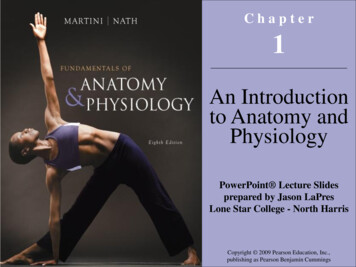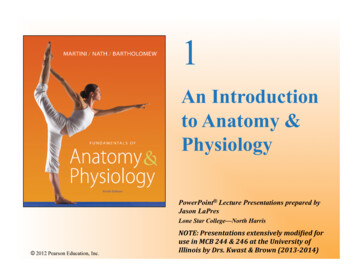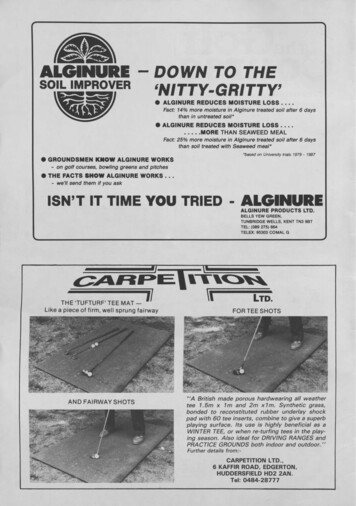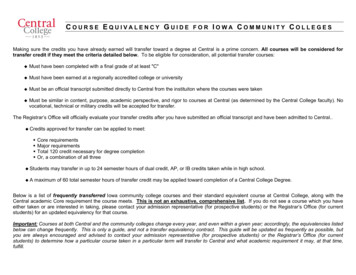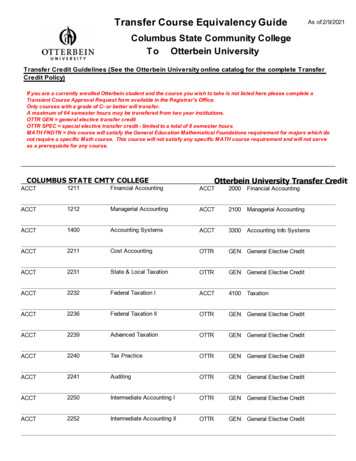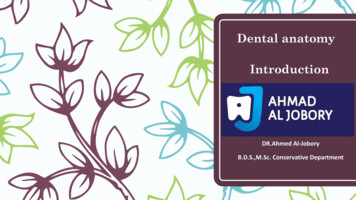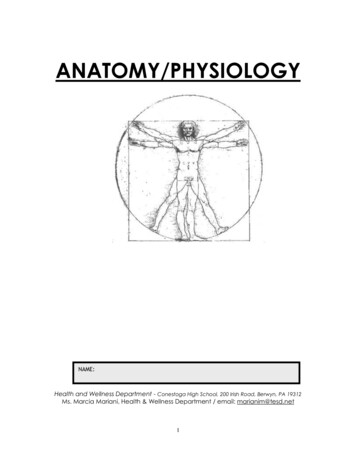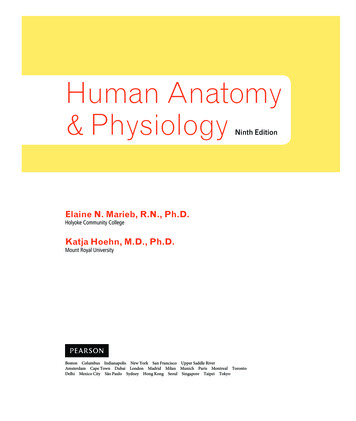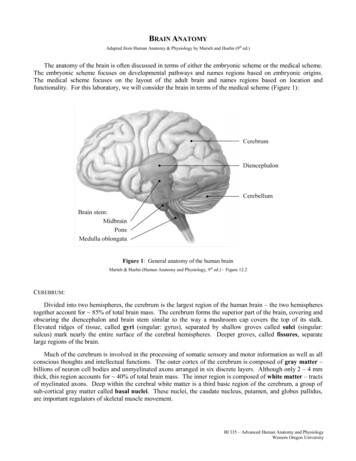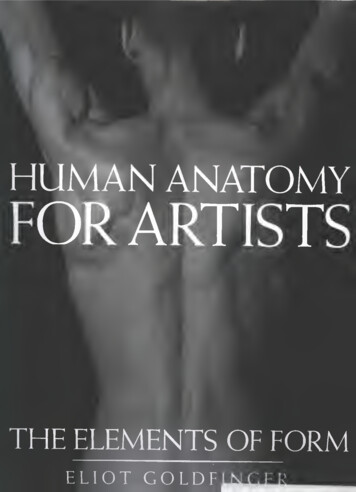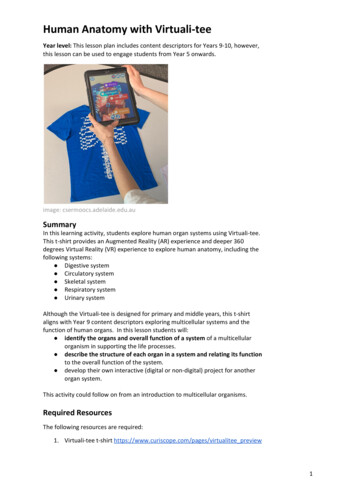
Transcription
Human Anatomy with Virtuali-teeYear level: This lesson plan includes content descriptors for Years 9-10, however,this lesson can be used to engage students from Year 5 onwards.image: csermoocs.adelaide.edu.auSummaryIn this learning activity, students explore human organ systems using Virtuali-tee.This t-shirt provides an Augmented Reality (AR) experience and deeper 360degrees Virtual Reality (VR) experience to explore human anatomy, including thefollowing systems: Digestive system Circulatory system Skeletal system Respiratory system Urinary systemAlthough the Virtuali-tee is designed for primary and middle years, this t-shirtaligns with Year 9 content descriptors exploring multicellular systems and thefunction of human organs. In this lesson students will: identify the organs and overall function of a system of a multicellularorganism in supporting the life processes. describe the structure of each organ in a system and relating its functionto the overall function of the system. develop their own interactive (digital or non-digital) project for anotherorgan system.This activity could follow on from an introduction to multicellular organisms.Required ResourcesThe following resources are required:1. Virtuali-tee t-shirt https://www.curiscope.com/pages/virtualitee preview1
2. A smartphone or tablet with the Curiscope “Virtuali-tee” App downloaded(Android or iOS available). Seehttps://www.curiscope.com/pages/virtualitee preview3. Printed human body templates (see template section).4. If proceeding with the research project, students will need access toInternet or a Library for researching their system and craft materials ortechnology to create their information.Suggested steps1. Prior to starting, students work in groups with a human body template(see template section for two options). Before using the t-shirts, they trytheir best to identify what they know about various human body systems,organs and their functioning by drawing, labelling and/or annotating.2. The class come together to share what they know about human organsand their functioning. The class comes together to display body templatesand together discuss similarities and differences between each group’srepresentations. As questions come up about human anatomy, theteacher writes them on the board.3. The teacher introduces the Virtuali-tee. The class break off into groupswith a virtuali-tee and device with the virtuali-tee curiscope app loaded.4. Students place the Virtuali-tee on a table or the floor for all to see.Students take turns navigating the App and exploring human anatomy inAR on the t-shirt.a. To use the app and the t-shirt, open the “Virtuali-tee” App on thetablet or smartphone device. Hover the app over the top of thet-shirt code until the human anatomy appears in AR. Navigate theapp by clicking on points of interest on the digital object. Studentscan move the tablet/phone device around to inspect the organsand bones.5. Students update their annotated diagram with information that theydiscover using the Virtuali-tee in AR and VR.6. The class comes together to discuss what they knew before and what theyupdated on their template by learning through the app.7. Students work in groups to critically reflect on the App, considering modesof presentation, user interactivity, strengths and weaknesses. These areshared back as a whole class, with the teacher summarising contributionson the whiteboard. From this, the class devise a set of “best practices” forpresenting biological information using digital technologies.8. The class then move onto a group project (see project brief in theassessment section) in which they research another human organ systemand work together to present an interactive educational experience toanother user about their chosen organ system, including the components,functioning and biological processes. This project could be developed2
using digital tools (e.g. Scratch, presentation software (e.g. Powerpoint,Prezi) or by creating a VR experience on Google Tour Builder).DiscussionThe following are some suggested discussion points throughout: What is a multicellular organism? What is unique about them incomparison to single cell organism. What are the key organs in the human body? What functions do they haveto support life processes in humans? Which systems are covered with the Virtuali-tee and which are not? What questions do you still have about the systems and organs? How does the App present the information to the user? What are thestrengths and weaknesses? How does the user interact with the App?Why is this relevant?Digital Technologies content: Students experience Augmented Reality (AR) andVirtual Reality (VR) designed for a particular educational purpose. Studentscritically evaluate this technology, examining the way the user interacts with theApp, the information presented and how AR and VR supports learning abouthuman anatomy. They consider future innovations of the technology and howthey can design their own interactive information resource.Science content: A tissue, organ or organism composed of many cells ismulticellular . Animals, plants, and fungi are multicellular organisms. A human is amulticellular organism, with multiple organs within the system - each with its ownfunction for human life processes. Multicellular organisms delegate biologicalresponsibilities (e.g. barrier, circulation, digestion, respiration) to specific organsystems (e.g. skin, heart, stomach, lungs). Unicellular organisms (single-celledorganisms) are smaller in size and less complex.AssessmentIn this lesson students will demonstrate the following learning: identify the organs and overall function of a system and how it relates tolife processesdescribe the structure of each organ in a system and relating its functionStudents evaluate critically the strengths and weaknesses of the app forpresenting educational information to a user and take into considerationways of presenting scientific nts can correctly describe amulticellular organism and provideexamples.Students identify the five organs ofthe human body covered in thelesson.3
Students describe the structure ofeach organ and their function forlife processes.Students describe how the Apppresents the information to theuser, and types of interactionsupported through technologyfunctions.Students critically evaluate the App,identifying strengths andweaknesses of the app forpresenting educational informationabout human anatomy.Title: Human Anatomy Assessment ProjectProject BriefWorking in a group, choose a human organ system to focus a project on that isnot covered in the Virtuali-tee Augmented Reality App.Undertake research (using reliable and/or evidence-based sources) to learnabout your human organ system, taking note on the components, functioningand processes involved.Present your information in an engaging way that teaches another person howthe organ system functions with some element of interactivity. You may chooseto present your information with or without technology. Please include awritten summary of your project including references used.You will be assessed on:The accuracy and detail of the information provided and the presentation of information for userinteractivity, demonstrating biological processes.For further advice, examples and support around assessment please visit theDigital Technologies Hub at digitaltechnologieshub.edu.au/teachers/assessment .Curriculum linksLinks with the Digital Technologies curriculum areaStrandContentdescriptionProcesses andProduction SkillsEvaluate critically how studentsolutions and existinginformation systems andpolicies, take account of futureYear bandYears 9-104
Years 9-10Processes andProduction SkillsYears 9-10Processes andProduction Skillsrisks and sustainability andprovide opportunities forinnovation and enterprise(ACTDIP042Create interactive solutions forsharing ideas and informationonline, taking into accountsafety, social contexts and legalresponsibilities (ACTDIP043)Plan and manage projects usingan iterative and collaborativeapproach, identifying risks andconsidering safety andsustainability (ACTDIP044)ADD Links with other curriculum areasLearningareaContentdescriptionYear 9Science - Science andInquiry SkillsYear 9Science - Science andUnderstandingCommunicate scientific ideasand information for a particularpurpose, including constructingevidence-based arguments andusing appropriate scientificlanguage, conventions andrepresentations (ACSIS174)Biological sciences:Multi-cellular organisms rely oncoordinated andinterdependent internalsystems to respond to changesto their environment(ACSSU175)Year bandADDITIONAL SUPPORTING RESOURCESYou might like to download and use Curiscope’s full lesson plan kit to use withprimary and middle years (some lessons could be adapted for older son-plans-human-bodyAuthor: Rebecca VivianThis work is licensed under a Creative Commons Attribution-NonCommercial 4.0International License . Computer Science Education Research (CSER) Group, The Universityof Adelaide.5
TEMPLATES (FROM WIKIMEDIA COMMONS)6
7
about human anatomy. Title: Human Anatomy Assessment Project Project Brief Working in a group, choose a human organ system to focus a project on that is not covered in the Virtuali-tee Augmented Reality App. Undertake research (using reliable and/or evidence-based sources) to learn about your human organ system, taking note on the components .
